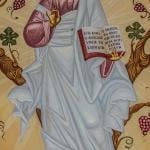
I found out today that the peace sign is semaphore.
I’d grown up thinking its origins were quite different and more sinister. But then again, I grew up with strange notions about a lot of innocent things.
My family spent several of my formative years in the Catholic Charismatic Renewal, a religious sect which took all of its political and cultural talking points from Evangelical Protestantism about ten years after Evangelical Protestantism was done with them. This is true so invariably that my former Baptist friend once listened to the story of my childhood and blurted out “When did Catholics become Baptist?” The consequence of this was that, for most people, the Satanic Panic was a phenomenon of the 1980s, but Charismatic Catholics were immersed in it in the 90s. Everything in the 90s was dangerous, because any random object might be a gateway to “the occult.” And if you opened a gateway to “the occult” in your home, God help you. You would be leaving yourself “open” to “influences” which would cause you to come down with “demonic oppression” or full-blown possession. Demonic oppressions were said to be the cause of every evil, from physical sickness to financial ruin to infestations of insects. Some demons could be expelled by sprinkling holy water around the house, but some were so stubborn they could infest your family tree and cause hereditary illness. We believed all that.
There was a never-ending list of things that were considered “pagan” and therefore demonic: role-playing board games, obviously. The celebration of Halloween. Psychedelic lighting. The Goosebumps series of books. Roald Dahl’s The Witches. The charming Disney movie Bedknobs and Broomsticks. Fantasy in general, if it wasn’t written by C. S. Lewis or J. R. R. Tolkein. Wearing clothing that looked “gothic.” The mythology of Asian cultures. Meditating. Yoga. Holding hands–that one wasn’t a common Charismatic phobia, but it was one I encountered because a lady from the Charismatic community said it could cause a demonic possession to jump from had to hand. I was allowed to be in the Girl Scouts for a certain amount of time, but my mother viewed many of their ceremonies as potentially pagan and dangerous. And I was also told not to draw peace signs on the peace pole I was making for a Girl Scout badge, because “The peace sign is a pagan symbol.” I was careful to stay away from the peace sign, for fear I’d come down with a demonic oppression. But I didn’t come down with a demonic oppression. I came down with a severe case of obsessive-compulsive disorder with a strong spiritual bent, and I’m still a bit eccentric to this day.
As I grew up and separated myself from the superstitions of the Charismatic Renewal, I began to un-learn my aversion to everyday things. One of my first rebellions was watching Bedknobs and Broomsticks. I have a special love for playing Dungeons and Dragons. I shake hands with people, or did before the pandemic, and when I do I don’t silently say a Hail Mary against demonic oppression.
I still assumed that the peace sign was a symbol appropriated from a pagan culture, but I didn’t care. Holly wreathes, Christmas trees and eggs have been used by pagans, but Christians baptized them. Celebrating Saint Brigid on Imbolc is an example of Christians baptizing something pagan. The Cross was something pagans murdered people with, and Christians use it as a symbol of everlasting life. The whole Roman empire was pagan before it wasn’t anymore. The Virgin Mary appeared to Saint Juan Diego wearing all kinds of Aztec symbols in her dress. That’s what Christians do. We baptize pagan things. I didn’t see how a peace sign was any different. I assumed the peace sign was a bad hippie appropriation of an ancient European culture– Goth, perhaps, or Norse or Celtic– the same way hippies appropriate the yin and yang without knowing what it means.
I asked my friends today on social media whether they’d been taught to fear the peace sign. And, in fact, a lot of them had. Here’s a sampling of the answers:
“I was told it was the symbol of a broken cross upside down.”
Image via Pixabay
Mary Pezzulo is the author of Meditations on the Way of the Cross and Stumbling into Grace: How We Meet God in Tiny Works of Mercy. Steel Magnificat operates almost entirely on tips. To tip the author, visit our donate page.












